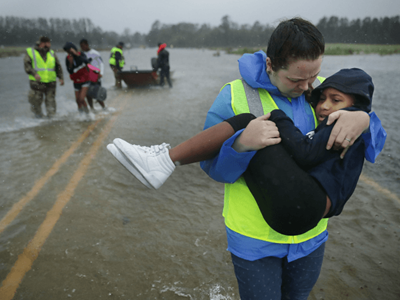Hurricanes are among nature’s most powerful and destructive forces. On average, six hurricanes will form during each Atlantic hurricane season and two during the Pacific hurricane season. The season is in full swing in both regions through November 30, and in the aftermath of Hurricane Florence in the Carolinas we have seen the damage these storms can cause.
While hurricanes pose the greatest threat to life and property, tropical storms and depression also can be devastating. The primary hazards are destructive winds, storm surge flooding, inland flooding from heavy rains and high surf and rip currents.
Storm surge, which is the abnormal rise of water generated by a storm’s winds, is the leading cause of damage and loss of life in the U.S. Flooding and winds also can cause massive destruction along coastlines and hundreds of miles inland.
Disaster Preparedness Can Save Lives
For those living and working in risk areas, knowing what actions to take before hurricane season begins and when a storm hits, as well as what to do afterwards, can increase the chances of reducing damage, improving recovery efforts and saving lives.
Natural disasters always occur at the local level. Local governments, volunteer agencies and area residents are the first to respond and lead recovery efforts when an event occurs, and they must plan and prepare for this role. Preparedness refers to measures taken to prepare for and reduce the effects of disasters. In the case of hurricanes, this means having a process in place for predicting and communicating about storms to help ensure no one is caught off-guard, as well as for protecting people and property from the impact of these dangerous and often devastating storms.
Every natural disaster is unique, and emergency responders have to quickly adapt to the ever-changing nature of a crisis. However, while speed is crucial during rescue and recover efforts, the need for safety is just as important as it is before and during a storm. Here are some of the basic essentials to have on hand so that emergency response teams, disaster recovery crews and volunteers can be ready to assist those in need and have access to the right equipment to help them stay safe.
High Visibility Safety Vests
Wearing proper safety vests will increase the safety and well being of authorized workers by reducing the risk of their not being readily seen. When selecting safety vests, High-Visibility Safety Apparel is the wisest choice because you can be assured they meet the requirements set by the American National Standard for High-Visibility Apparel (ISEA). All apparel should be properly labeled as meeting the ANSI 107-1999 standard performance for Class 2.
Electronic Safety Baton
The Electronic Safety Baton is the most common light used to direct traffic. This LED baton is 20″ long and the red portion of the wand is 13″ in length. It has two functions, Red flashing and Red steady, and is also available in a 7” model.
Water Fillable Barricades
Water Fillable Barricades are ideal for use in temporary work zones and to identify road detours. Made of high density polyethylene, these barricades are lightweight, can conform to any roadway design and no heavy machinery is required for installation when empty.
Classic Folding Barricades
The 40” Classic Folding Barricade is the standard for high quality traffic barricades. These plastic barriers provide a safer alternative and have a lower liability than metal or wooden barricades. They meet MUTCD specifications and come with provisions for a mounting light.
Breakaway Barricades Type III
Type III Breakaway Barricades are NCHRP 350 compliant and quick and easy to set up and take down. The top U channel piece snaps into the bottom base, and they never rust or splinter. Ballasting is with water (warmer climates), sand or sandbags.
When you need proper equipment you can rely on to protect workers and residents in any emergency situation, contact Traffic Safety Direct. We love to help, answer questions and share our experience.
